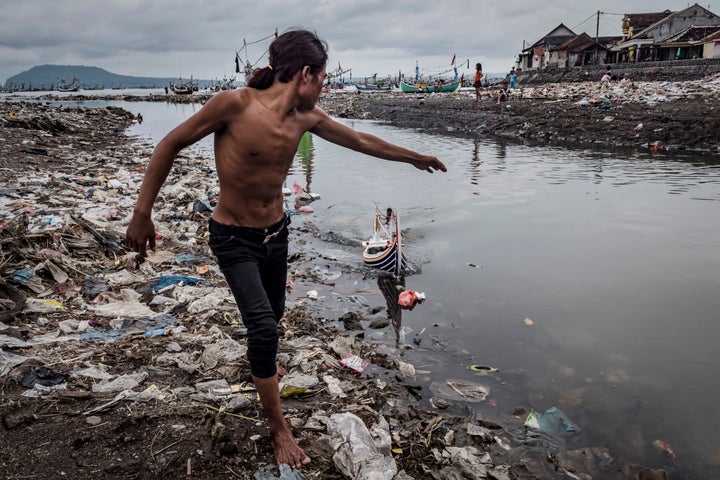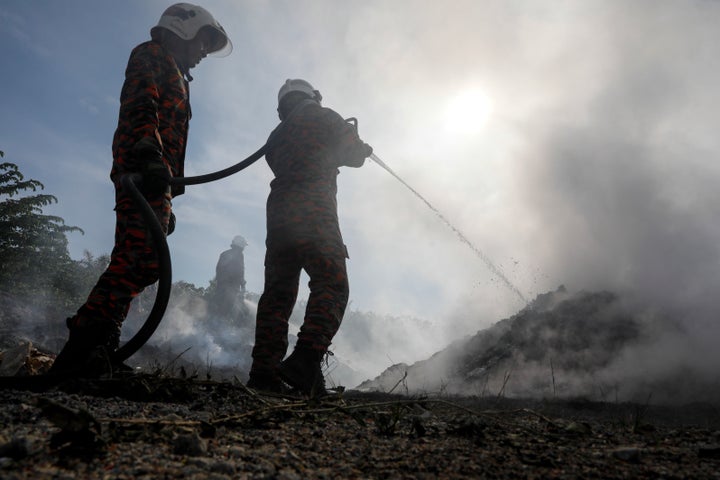The world is facing an enormous trash problem. Even in countries like the United States, which has strong infrastructure for waste disposal and collection, the sheer scale of trash production presents a challenge. Poorer countries, where trash infrastructure is underdeveloped or nonexistent, cannot possibly keep up.
Plastic trash is a particularly thorny issue. Cheap to produce and tough to recycle, most consumer plastics ― like food packaging and shopping bags ― end up mixed in with other types of garbage. And, in many parts of the developing world, people have few choices but to dump their trash in waterways or burn it in open pits to get rid of it.
Plastic is burned at an alarming rate in low- and middle-income countries, according to a May 14 report by Tearfund, Fauna & Flora International, WasteAid and The Institute of Development Studies. Around the world, a double-decker busload of plastic is burned or dumped every second, the report found, equivalent to 70 million metric tons of burned or dumped plastic annually.

Burning plastic releases chemicals into the air that are highly toxic to humans and can increase the risk for heart disease, cause rashes, nausea and headaches, and cause damages to the nervous system, kidney and liver. Aggravated respiratory conditions like asthma and emphysema are also linked to burning plastics, according to the organization Women In Europe for a Common Future.
The Tearfund report focuses on open-pit burning, an unregulated disposal method that rarely curbs or reduces toxins. The authors explain that the air pollutants created through open burning “are often produced in close proximity to human habitation (often in backyards in informal settlements).”
Incineration facilities, by contrast, are used in developed areas to dispose of trash, but these are usually tightly controlled and highly regulated. While there are certainly health and air pollution risks associated with older incinerators, newer ones are supposedly safer. According to National Geographic, 12% percent of the plastic in the U.S. is sent to incinerators, while only 9% is recycled.
The U.S. ships the majority of its plastic refuse abroad. This waste can end up in unregulated or illegal disposal processes, which include burning. A significant amount of the world’s plastic refuse is exported to Southeast Asian nations, including Malaysia, Vietnam and Indonesia. A recent study by Greenpeace and the Global Alliance for Incinerator Alternatives focused on areas in Southeast Asia that have been inundated with foreign plastic over the past year and found that these areas could not manage the flow of waste from industrialized countries.

“Wealthy countries had grown accustomed to exporting their plastic problems, with little thought or effort to ensure that the plastic they were exporting got recycled and did not harm other countries,” the Greenpeace-GAIA report authors wrote. “North Americans and Europeans exported not just their plastic waste, but the pollution that went with getting rid of it.”
The American Chemistry Council, a trade association for chemical companies, pushed back on some of the findings presented in the May 14 study, but condemned the burning and dumping of garbage.
“There is no question that dumping of waste in streams and rivers, on roadsides or open spaces, and open pit burning of waste is neither healthy nor sustainable,” Steve Russell, vice president of the group’s plastic division, said in a statement.
The authors of the report write that companies and governments should be held accountable by reducing the amount of plastic produced and by providing alternative packaging to consumers.
Activist groups hope reports like this one will force companies to step up their search for solutions.
“Plastics’ threats to our oceans and marine life should have been enough to concern the industry producing this material decades ago,” Jacqueline Savitz, chief policy officer of North America for Oceana, said in a statement emailed to HuffPost.
For its part, the corporate world is taking steps toward action. Earlier this year, for example, a group of more than two dozen companies announced the Alliance to End Plastic Waste. The group, which includes some of the top plastic producers ― including Dow Chemical, ExxonMobil, Formosa Plastics Corp. and Procter & Gamble ― has pledged $1.5 billion toward keeping plastics from polluting the environment.
This story is part of a series on plastic waste, funded by SC Johnson. All content is editorially independent, with no influence or input from the company.

